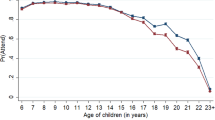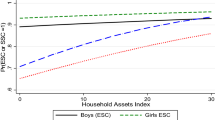Abstract
Social investment in schooling in low-income countries has increased greatly in the 1990s and 2000s because of the robust associations among schooling and demographic, economic, and health outcomes. This analysis investigates whether targeted school-attendance stipend programs succeeded in reducing gender and socioeconomic inequalities in school attainment among a sample of the rural poor in Bangladesh. Multivariate analyses find that targeted stipend programs helped to reduce the gender attainment gap. Females had an increased probability of participating in stipend programs, and returns to stipend participation were significantly higher for females. However, stipend programs failed to reduce the relative achievement gap between children of different socioeconomic backgrounds: low socioeconomic status (SES) was associated with a decreased probability of stipend participation, and stipend-related schooling gains for lower-SES females were matched by comparable gains for higher–SES females. Meanwhile, there was no significant association between stipend participation and schooling attainment for males.
Similar content being viewed by others
Notes
A trial version of the FSP was launched by an NGO in 1982 on a small scale in six pilot areas. The program was scaled up to the national level with public financing in 1994.
Research suggests that mother’s and father’s resources may differentially affect children’s outcomes (Quisumbing and Maluccio 2003). I rerun all analyses using gender-disaggregated variables for mother’s and father’s education and wealth; however, I do not find significant differences in the predictive power of mother’s versus father’s resources for the outcomes of interest.
All descriptive percentages are approximate because of rounding.
The Female Secondary School Stipend Program was targeted exclusively to females. However, six male children in the sample reported receiving the Female Secondary School Stipend. This discrepancy could be due to measurement error or erroneous program targeting. I reran all analyses excluding these six respondents, and results were unchanged.
References
Adato, M., & Hoddinott, J. (2010). Conditional cash transfers in Latin America. Baltimore, MD: The Johns Hopkins University Press for the International Food Policy Research Institute.
Adato, M., Roopnaraine, T., & Becker, E. (2011). Understanding use of health services in conditional cash transfer programs: Insights from qualitative research in Latin America and Turkey. Social Science & Medicine, 72, 1921–1929.
Ahmed, A. U., & Arends-Kuenning, M. (2006). Do crowded classrooms crowd out learning? Evidence from the food for education program in Bangladesh. World Development, 34, 665–684.
Ahmed, A. U., & del Ninno, C. (2002). The Food for Education Program in Bangladesh: An evaluation of its impact on educational attainment and food security (Food Consumption and Nutrition Division working paper). Washington, DC: International Food Policy Research Institute.
Asadullah, M. N., & Chaudhury, N. (2009). Reverse gender gap in schooling in Bangladesh: Insights from urban and rural households. Journal of Development Studies, 45, 1360–1380.
Baulch, B. (2011). The medium-term impact of the primary education stipend in rural Bangladesh. Journal of Development Effectiveness, 3, 243–262.
Chowdhury, A., Nath, S. R., & Choudhury, R. K. (2002). Enrolment at primary level: Gender difference disappears in Bangladesh. International Journal of Educational Development, 22, 191–203.
Deaton, A. (1997). The analysis of household surveys: A microeconometric approach to development policy. Baltimore, MD: The Johns Hopkins University Press for the World Bank.
de la Briere, B., & Rawlings, L. (2006). Examining conditional cash transfers. A role for increased social inclusion. In L. D’Andrea (Ed.), Social protection and inclusion: Experiences and policy issues (pp. 9–32). Geneva, Switzerland: International Labor Organization.
Fiszbein, A., & Schady, N. (2009). Conditional cash transfers: Reducing present and future poverty (World Bank Policy research report). Washington, DC: The World Bank.
IFPRI-BIDS-IFNS. (1998). Commercial vegetable and polyculture fish production in Bangladesh: Their impacts on income, household resource allocation, and nutrition (Donor report). Washington, DC: International Food Policy Research Institute.
Jones, P. W. (2012). World Bank financing of education: Lending, learning and development. Washington, DC: The World Bank.
King, E., & Mason, A. D. (2001). Engendering development: Through gender equality in rights, resources, and voice (World Bank Policy research report). New York, NY: World Bank and Oxford University Press.
Quisumbing, A. R., & Maluccio, J. (2003). Resources at marriage and intrahousehold allocation: Evidence from Bangladesh, Ethiopia, Indonesia, and South Africa. Oxford Bulletin of Economics and Statistics, 65, 283–327.
Rahman, H. Z., Hossain, M., & Sen, B. (Eds.). (1996). 1987–1994: Dynamics of rural poverty in Bangladesh. Dhaka, Bangladesh: Bangladesh Institute of Development Studies.
Schurmann, A. T. (2009). Review of the Bangladesh Female Secondary School Stipend Project using a social exclusion framework. Journal of Health, Population, and Nutrition, 27, 505–517.
United Nations (UN). (2001). Road map towards the implementation of the United Nations Millennium Declaration: Report of the Secretary-General. New York, NY: United Nations Department of Public Information.
Yount, K. M., Maluccio, J. A., Behrman, J. R., Hoddinott, J., Murphy, A., & Ramakrishnan, U. (2013). Parental resources, schooling achievements, and gender schooling gaps: Evidence of change over 25 years in rural Guatemala. Population Research and Policy Review, 32, 495–528.
Acknowledgments
Background support for this study was provided by the grant Team 1000+ Saving Brains: Economic Impact of Poverty-Related Risk Factors for Cognitive Development and Human Capital “0072-03” provided to the Grantee, the Trustees of the University of Pennsylvania by Grand Challenges Canada. I am grateful to Jere Behrman for support and guidance throughout the development of the article. Pat Sharkey, Larry Wu, Florencia Torche, Paula England, Sara Duvisac, Abigail Weitzman, Monica Caudillo, Wahid Quabili, and Agnes Quisumbing provided helpful comments and assistance. I benefited from comments from participants of the American Sociological Association annual meeting, Population Association of America annual meeting, Sociology of Development annual meeting, NYU inequality workshop, and NYU graduate student conference.
Author information
Authors and Affiliations
Corresponding author
Rights and permissions
About this article
Cite this article
Behrman, J.A. Do Targeted Stipend Programs Reduce Gender and Socioeconomic Inequalities in Schooling Attainment? Insights From Rural Bangladesh. Demography 52, 1917–1927 (2015). https://doi.org/10.1007/s13524-015-0435-9
Published:
Issue Date:
DOI: https://doi.org/10.1007/s13524-015-0435-9




